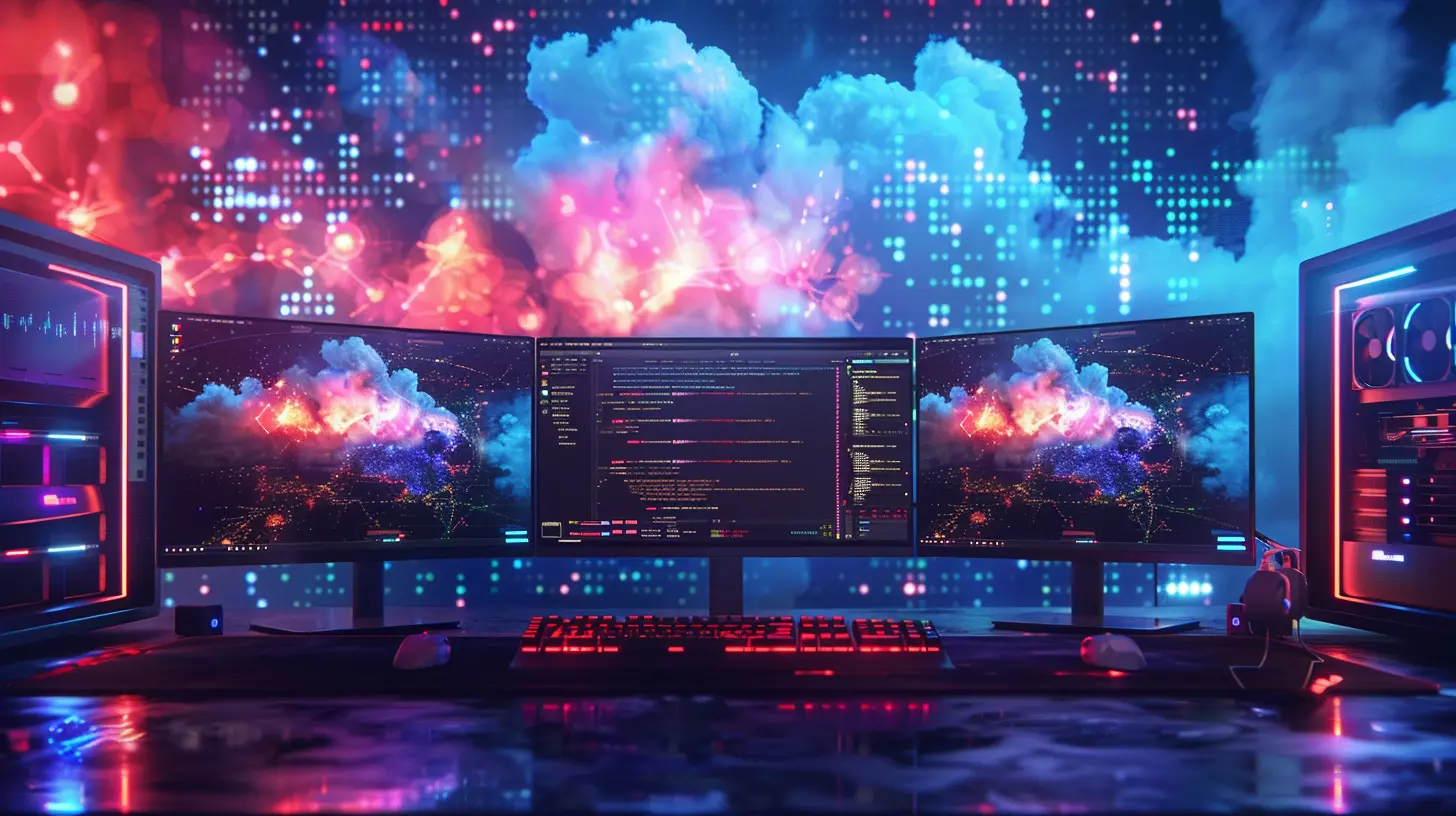How Cloud Gaming Is Influencing Game Graphics
20 September 2025
Let’s take a moment and imagine this: You’re sitting on your couch with a smartphone in hand, no console in sight, and yet you’re playing a AAA title with the kind of jaw-dropping graphics you’d expect from a top-tier PC. Sounds like sorcery? Nope—it’s cloud gaming in action.
Cloud gaming is shaking up the gaming world in more ways than one, but one of the most fascinating changes is how it's redefining game graphics. It’s no longer just about how strong your hardware is—now, it’s about how good your internet connection can be. So, how exactly is cloud gaming shaping the future of game visuals? Let’s dive in.
What Is Cloud Gaming, Really?
Before we geek out on graphics, let’s clear the air on what cloud gaming actually is. In simple terms, cloud gaming lets you stream games over the internet. Think Netflix, but for video games. Instead of downloading or installing a game, you play it directly from a remote server or data center.These data centers are stocked with high-performance hardware—far better than most personal gaming setups—and they do all the heavy lifting. Your device, whether it's a phone, Chromebook, or smart TV, just acts as a screen and controller. The result? High-end gaming without the high-end gear.
Elevating Graphics Without Upgrading Hardware
One of the biggest wins of cloud gaming is that it breaks the long-standing chain between graphics and hardware specs. In the past, if you wanted better visuals, you had to fork out for more RAM, a better GPU, a faster CPU—the whole shebang. But cloud gaming flips that on its head.Remote Rendering Takes the Wheel
Instead of rendering frames on your own machine, cloud gaming services render them on their powerful servers. These servers are optimized for top-of-the-line performance, meaning they can push ultra settings, ray tracing, and lifelike textures without breaking a sweat.Then, they compress the video feed and stream it straight to you. So, even if you’re on a tablet, you’re still getting that deliciously detailed gameplay. The device no longer limits the experience.
The Rise of Ultra-Realistic Graphics
With cloud gaming removing bottlenecks, developers are going wild with visuals—and who can blame them?Ray Tracing Becomes Mainstream
Ray tracing used to be a luxury reserved for gamers with beast rigs. Now, with cloud gaming platforms like NVIDIA GeForce Now or Google Stadia, ray tracing is much more accessible. Everything from reflections to shadows to lighting effects looks mind-blowingly realistic.Imagine catching a sunset in a game and seeing the light bounce off every surface, all in real time. That’s no longer just PC master race territory—that’s cloud gaming power.
Consistent Performance Across Devices
One of the less obvious but super important aspects is consistency. Developers can optimize their graphics for a single platform—the cloud—without worrying about different hardware configurations. This means fewer compromises and more attention to detail.Whether you’re on Android or iOS, a smart TV or a budget laptop, the experience looks practically the same. This kind of visual parity was near impossible before.
Lower Hardware Barriers = More Ambitious Games
When you don’t have to worry about your game destroying someone's GPU, you get the freedom to break creative limits.Bigger Worlds, Richer Environments
Developers can now go ham on larger worlds filled with more objects, NPCs with complex animations, and environments bursting with detail. Why? Because they’re not worried about frying your console.This especially benefits open-world games. Think "Cyberpunk 2077" or "Red Dead Redemption 2" but scaled to even more breathtaking levels. The cloud can render dense cities, weather systems, facial expressions, and AI routines all at once—without your device puffing smoke.
Higher Fidelity on Any Screen
Even mobile gamers can finally experience console-quality graphics. Through the magic of pixel streaming and adaptive bitrate technology, the visuals adjust on the fly so you get the best experience based on your network quality.So yeah, your old iPad might not support ray tracing natively, but with cloud gaming? You're basically holding a mini graphics powerhouse.
The Role of AI in Enhancing Graphics
Cloud gaming isn't doing all this alone. AI is jumping in like a tech-savvy sidekick, helping games look even better without burning bandwidth.AI Upscaling
Services like DLSS (Deep Learning Super Sampling) use AI to upscale lower-resolution images to higher resolutions, making them look crisp without needing more GPU power. It’s like giving your game a fresh coat of polish without repainting the whole house.And since this happens on the server side, gamers don’t even need to know it’s going on. They just enjoy smoother, cleaner graphics.
Smart Streaming Compression
Graphics aren't just about pretty pixels—they’re also about delivering them efficiently. AI helps compress video streams in smarter ways, focusing detail where players are looking and reducing data usage elsewhere. Fewer artifacts, more beauty.Challenges Still Lurking in the Background
Okay, real talk: It’s not all pixel-perfect sunshine and rainbows. Cloud gaming still faces some hurdles that can mess with your visual experience.Latency Can Affect Perceived Quality
Even with fiber internet, latency—or that annoying lag between your input and the game responding—can impact how you perceive graphics. A game might look stunning, but if there’s just enough delay, it taints the whole experience.Graphics may stutter, frames might drop, and textures could pop in awkwardly. So while the potential is huge, it’s only as strong as the weakest link—your connection.
Bandwidth Requirements
Beautiful graphics need data. A lot of it. Playing in 4K with ray tracing? Say hello to data caps. Cloud gaming demands a fast and stable connection, and not everyone has access to that.Until internet infrastructure and pricing catch up globally, cloud gaming won’t fully replace traditional hardware-based gaming.
How Developers Are Adapting Their Art Style
What’s exciting is how game studios are reimagining art direction to suit the cloud.Pushing the Limits with Stylized Visuals
Not every game needs to be photorealistic. Some developers are leaning into stylized art—cel-shading, minimalism, surrealism—blending graphical innovation with bold artistic design. With fewer constraints, teams can experiment more and drive fresh visual identities.Cloud-Native Game Design
This is a whole new genre in the making: games built for the cloud. These titles are designed assuming massive computing power and stable streaming, letting devs go wild with procedural environments, adaptive lighting, and real-time destruction physics.It’s like painting on a canvas that keeps getting bigger and more colorful—the only limit is imagination.
What's Next for Game Graphics in the Cloud Era?
Let’s peek into the crystal ball. Where are things headed?8K Streaming and Beyond
We barely settled into 4K, and now 8K is already waiting in the wings. Cloud gaming can pave the way for 8K gaming without requiring anyone to upgrade their gear—just their internet. The fidelity, texture detail, and sharpness this will bring? Unreal.True Cinematic Experiences
We could start seeing games that look and feel more like blockbuster films. With real-time cinematics, hyper-real character models, and emotionally reactive environments—the line between movie and game gets blurrier by the frame.Cross-Device Visual Fidelity
One of the biggest changes will be visual consistency across platforms. You won’t have to wonder, “Will this game look worse on my phone?” because it won’t. The cloud levels the playing field, and that’s never been done before in gaming history.TL;DR: Cloud Gaming Is a Game-Changer for Graphics
Let’s wrap it up:Cloud gaming isn't just convenient—it’s revolutionizing how we experience graphics in games. By decoupling visuals from hardware limitations, it opens the doors for ultra-realistic environments, massive game worlds, and consistent performance across devices.
Sure, there are still bumps in the road—like latency and bandwidth—but the momentum is undeniable. The sky’s the limit (pun totally intended), and game designers now have a more powerful canvas than ever before.
So next time you see a game running like a dream on a potato device, remember: It’s not magic—it’s the cloud.
all images in this post were generated using AI tools
Category:
Cloud GamingAuthor:

Whitman Adams
Discussion
rate this article
1 comments
Daisy Strickland
Great insights! It's fascinating to see how cloud gaming is pushing the boundaries of graphics. The potential for enhanced visuals and seamless experiences could redefine our gaming experiences. Excited to see where this technology takes us next! Keep up the good work!
September 21, 2025 at 4:11 AM

Whitman Adams
Thank you! I'm glad you found the insights valuable. The future of cloud gaming does look promising, and I'm excited to explore its evolving impact on graphics and gameplay!


